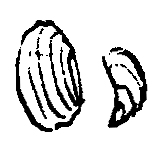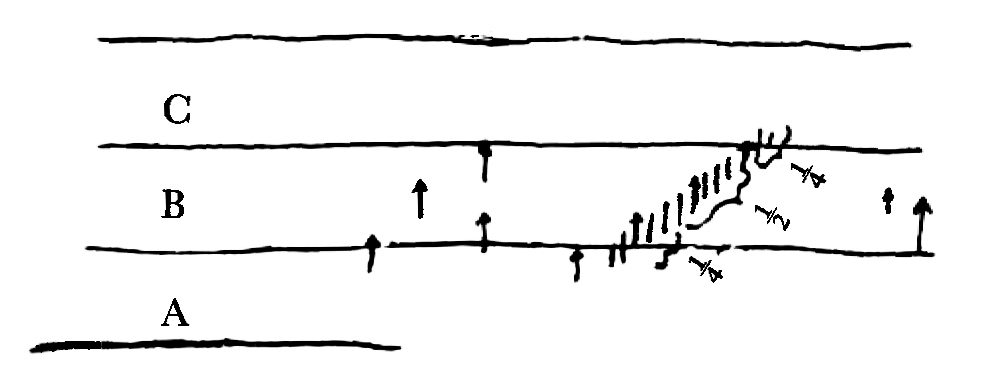To S. P. Woodward [after 4 June 1856]1
[Down]
p. 353. Genera found in Arctic countries, & in S. Hemisphere.2
Are they never found in Tropics??3
Chrysodomus (p 109) no southern Habitat given)4 (p. 109) Cuming5 says in St. of Macassar
Trophon (I thought there were some aberrant Tropical forms) North. Falklands. New Zealand.6
Trichotropis (p. 109) (no southern habitat given.)7
Margarita (p 144) Greenland. Brit. Falkland Isld.8
Rhynchonella (p. 227) Melville Isd. &c. New Zealand.9
Crenella (p. 266) Nova Zembla. &c New Zealand.10
Yoldia (p 270) “Arctic & Antarctic seas— Greenland.11 Massachussetts Brazil!! (no S. Habitat given)12
Astarte (p. 299) Behring St. Norway Canaries (no S. Habitat given)13
(I see Forbes (in new map.) gives Patina in N. & S. & not in Tropics.—)14
p. 371. Is it really certain that Monoceros is in New Zealand?15 Was Sowerby right that one of my Patagonian fossils is a Struthiolaria?16
Is Bankivia confined to Cape & N. Zealand, (page wrong in Index).—17 Do you mean that Venus Stutchburyi & Modiolarca trapezina are common to New Zealand & Kerguelen Land.—18
p. 382. Do you know whether any of the same species of F. W. shells have very wide ranges.?—19 p. 397. Does Dr. Gould give distribution of individual species of Land Molluscs in Pacific islands.—20 Pfeiffer gives several in common to rather distant islds.; but can he be trusted?21
p. 410 How do you calculate that each Geolog. period = 3 times average duration of species.22
p. 411. (first paragraph) do you think you have really good evidence in regard to numbers of individuals.23
p. 411. (3d. par.) & p. 419—(bottom) Longevity of Land & F.W. molluscs great: is it so compared with sea-molluscs, or land vertebrata? Is there means of comparing longevity of land & F.W. Molluscs?24
p. 414 Table, what meaning of names in Italics?25
p 421. Is Cardium edule var. rusticum, found either fossil or recent elswhere, besides in White Sea.26
p 421. (4th. Par) I cannot find what is distrib. of recent species of Fulgur:27 Is it certain that there is a Gnathodon (p 309) in Moreton Bay? What is range of living Mercenaria (p 305).—28
Footnotes
 “Buccinum” antarcticum, Falklands, = Pisania–Bivon. operc. claw-like. —— ligatum &c Cape = Cominella, Gr. operc. like Turbinella Woodward refers to Orbigny 1835–47 and Quoy and Gaimard 1830[–4]. Next to this, CD wrote ‘Used’ in pencil.
“Buccinum” antarcticum, Falklands, = Pisania–Bivon. operc. claw-like. —— ligatum &c Cape = Cominella, Gr. operc. like Turbinella Woodward refers to Orbigny 1835–47 and Quoy and Gaimard 1830[–4]. Next to this, CD wrote ‘Used’ in pencil.
Bibliography
Forbes, Edward. 1856. Map of the distribution of marine life, illustrated chiefly by fishes, molluscs and radiata; showing also the extent & limits of the homoiozoic belts. Pp. 99–102 of vol. 4 of Johnston, Alexander Keith, ed., The physical atlas of natural phenomena. 2d ed. 4 vols. Edinburgh and London.
Gould, Augustus Addison. 1852–6. Mollusca & shells. Vol. 12 and atlas of United States Exploring Expedition during the years 1838–42. Under the command of Charles Wilkes, U.S.N. Boston: Gould & Lincoln. Philadelphia: C. Sherman & Son.
Orbigny, Alcide Charles Victor Dessalines d’. 1835–47. Voyage dans l’Amérique Méridionale (le Brésil, la République orientale de l’Uruguay, la République Argentine, la Patagonie, la République du Chili, la République de Bolivia, la République du Pérou), exécuté pendant les années 1826 … 1833. 6 vols. in 7 and 4 atlases. Paris and Strasbourg: Pitois-Levrault et Cie, P. Bertrand.
Pfeiffer, Ludwig George Karl. 1848. Monographia heliceorum viventium. Sistens descriptiones systematicas et criticas omnium huiuas familiae generum et specierum hodie cognitarum. 2 vols. Supplement, 4 vols. in 6. 1853–77. Leipzig.
South America: Geological observations on South America. Being the third part of the geology of the voyage of the Beagle, under the command of Capt. FitzRoy RN, during the years 1832 to 1836. By Charles Darwin. London: Smith, Elder & Co. 1846.
Woodward, Samuel Pickworth. 1851–6. A manual of the Mollusca; or, a rudimentary treatise of recent and fossil shells. 3 pts. London. [Vols. 6,8,9]
Summary
Queries from CD on the distribution of molluscan genera referring to SPW’s Manual of the Mollusca [pt 3 (1856)], with SPW’s answers.
Letter details
- Letter no.
- DCP-LETT-1890
- From
- Charles Robert Darwin
- To
- Samuel Pickworth Woodward
- Sent from
- Down
- Source of text
- DAR 72: 59–61
- Physical description
- Amem 3pp ††, † (by CD)
Please cite as
Darwin Correspondence Project, “Letter no. 1890,” accessed on
Also published in The Correspondence of Charles Darwin, vol. 6


